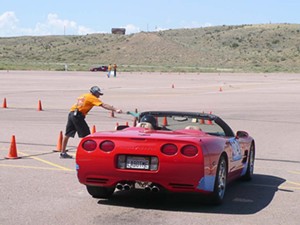
Halloween means candy, costumes, and trick-or-treating, but for Charlie Perry and the rest of the members of the local Corvette car club, the holiday also means it’s time to get back on the track.
After two years of searching for a venue, the Santa Maria Vapor Trail Vettes reached a final agreement with Allan Hancock College on Sept. 28. The group will hold its low-speed autocross events at a parking lot on the college’s Lompoc campus. The first event is set for Oct. 31.
“It looks like it’s going to be a lot of fun,” Perry said. “The whole idea is to set up a course that’s safe. Having fun and being safe are the two dominant things that we stress.”
Perry serves as the club’s governor and has participated in low-speed autocross events for five years. He was drawn to the competition after he fell in love with driving his wife’s Corvette and relished the opportunity to polish his driving skills.
“I don’t know if I know what I’m doing all the time, but I enjoy it,” Perry said. “It teaches you to constantly look ahead and keep your eyes moving left to right. When you exit a corner, you’re looking beyond the next corner.”
Each autocross course is different, but the idea is the same. Drivers must swerve, slalom, and otherwise skillfully maneuver through an obstacle course of safety cones as quickly as possible, without knocking them over. Any dislodged cones, and the driver loses points.
In low-speed autocross events, the drivers must stay below an 80-mph speed limit. Drivers must first master the events before moving up to higher-speed autocross.
The Vapor Vettes, which formed in 2003 with the intention of bringing competitive Corvette driving events to Santa Maria, used to hold several autocrosses each year at the Santa Maria Airport. Tighter Department of Homeland Security restrictions on airport use shut them down in 2007.
Vapor Vettes president Gale Haugen said the airport was always supportive.
“They were very fond of our events,” she explained. “We were always safety-conscious. That’s No. 1 to us.”
Perry, who also races in high-speed events, said the goal of the low-speed event is to finish the course quickly while still being able to drive the car home in one piece.
“You’re not racing, you’re just trying to get through it as fast as possible and as safe as possible,” Perry said. “You don’t want anybody getting hurt, you don’t want anybody hurting their cars. If they don’t get in an accident, then they’re having fun.”
The autocrosses are sanctioned by the national council, a nonprofit organization founded in 1959. With affiliated clubs stretching from coast to coast, including the Vapor Vettes, the council claims a nationwide membership of about 18,000.
The council gives points to its members for attending functions and keeps track of scores and times in autocross and drag racing events.
Individual member clubs can set up autocross courses in any configuration, as long as it holds to the council’s safety regulations. Perry is in charge of the design for the Vapor Vettes.
“You want to make it fun and challenging for the driver,” Perry said. “These cars are built for speed, but they’re also built for handling; some have more horsepower, some have less. In a low-speed autocross, horsepower isn’t an advantage, but it’s a challenge because it’s teaching you how to use the car.”
Competition is not limited to Corvettes. Autocrosses are open to all comers, and with the only requirement being that the vehicle must corner well, it’s not uncommon to see Mini-Coopers, Porsches, and BMWs on the track.
According to Perry, drivers generally make four to six course runs, lasting about 50 seconds apiece, so there’s not much wear and tear on the cars.
If the club can maintain the new location at Hancock, Haugen said, they’ll probably hold about four autocross events there per year.
Both men and women can compete, and while the club does hand out trophies for the top competitors, the event is as much a race against the clock as it is against each other, Haugen said.
“It’s a test of your driving abilities, to maneuver this without knocking any cones off,” she said. “It keeps the cars going. To stay on the track, they’ve got to keep it at a lower speed.
“It’s really a kick,” she added.
Staff Writer Jeremy Thomas can be contacted at [email protected].









